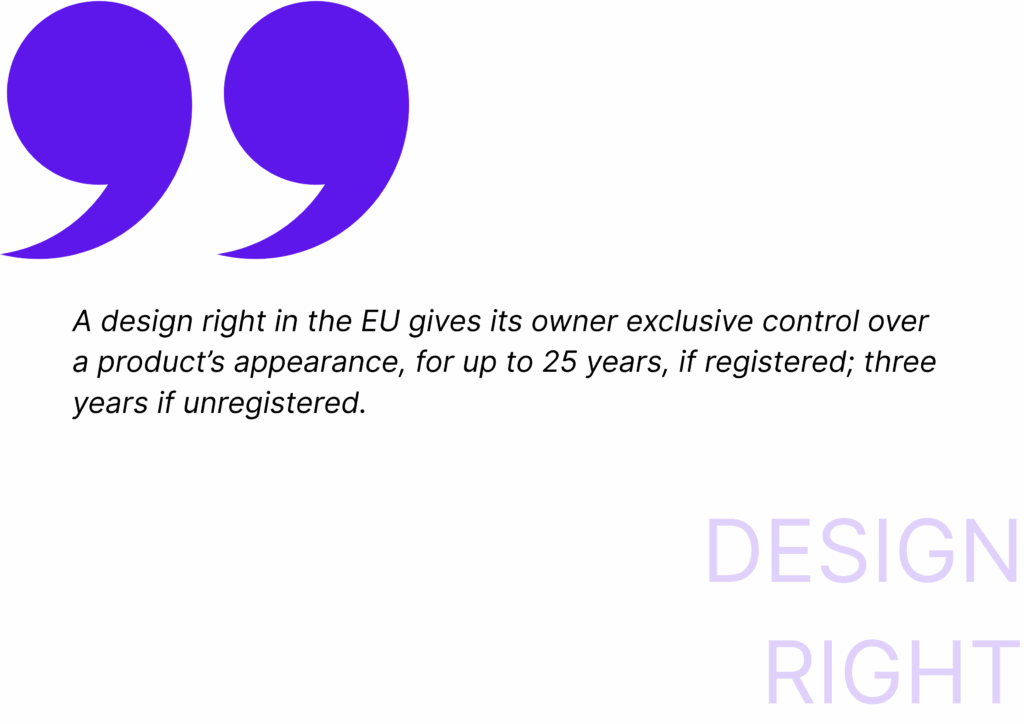A design right in the EU gives its owner exclusive control over a product’s appearance, for up to 25 years, if registered; three years if unregistered.
Why design rights matter
However, a clear design right strategy equips emerging businesses with leverage when negotiating funding, manufacturing or licensing deals. What is a design right in the EU ? is not academic: a recognised design right in the EU signals professionalism to investors. Copying costs little; litigation costs millions. It’s not something to not take care of : the design right is a valuable process that can help the valuation of your project, or the protection of your business.
Registered vs unregistered
Moreover, the Registered EU Design (formerly “Community design”) grants a renewable five-year monopoly, capped at 25 years, provided the design is novel and has individual character. The Unregistered EU Design arises automatically upon first disclosure in the European Economic Area and lasts three years—perfect for short-life fashion or digital content. Ideas spark progress.
Protecting and enforcing your design
Meanwhile, the 2025 reform streamlines filing through EUIPO: a single online form, real-time fee calculator and the option to file up to 20 designs in one batch. What if a competitor launches a near-identical product the week after you exhibit at a trade fair? Acting within the grace period (12 months from self-disclosure) lets you file despite earlier publicity, blocking the copycat’s sales.
- Check novelty across existing designs via EUIPO’s DesignView.
- File within the 12-month grace period to keep novelty intact.
- Mark products with the design number to deter infringement.
- Monitor marketplaces and send EUIPO’s Customs Watch notices.
- Use WIPO’s Hague System for protection beyond the EU.
Therefore, Berlin-based scooter startup “SwiftRide” registered its folding-handlebar design in March 2025. Within weeks, a low-cost clone appeared online. SwiftRide’s EU design registration allowed swift takedowns on Amazon and a customs seizure at Rotterdam. The registration cost under €500; the enforcement saved an entire production run.
Additionally, infringement cases now move faster because the amended Regulation introduces optional EUIPO dispute boards that can mediate conflicts for a fraction of court costs. These boards deliver decisions enforceable across all 27 Member States, avoiding parallel litigation in multiple languages.
Notably, the 2025 fee schedule reduces the application fee for the first design to €75, down from €230, and introduces a flat €5 fee for each extra view. Startups can illustrate product variants—colours, surface patterns, GUI animations—without blowing the budget.
Furthermore, digital-only designs such as icons, NFTs or virtual fashion are expressly eligible. The law now accepts MP4 uploads showing movement, extending protection to loading animations and dynamic user interfaces—critical assets for software-as-a-service ventures.

Subsequently, the much-debated “repair clause” limits enforcement against component parts used to restore a complex product to its original appearance, provided the spare part matches shape and colour. Car aftermarket suppliers gain certainty, while design owners still receive royalties on original sales.
Conversely, national design systems remain relevant for businesses targeting a single Member State. French “dessins et modèles” and German “eingetragenes Design” offer local courts and lower renewal fees. Nevertheless, the EU right gives automatic coverage in every export market, simplifying growth once product-market fit is proven.
Therefore, founders should map their rollout: launch in one country with a national filing, or leapfrog straight to the EU system? The answer depends on funding, manufacturing footprint and tolerance for public disclosure. A staged approach—first filing nationally, then extending via the Hague System—often balances cash flow and risk.
Ultimately, design rights integrate neatly with patents and trade marks. A smartwatch may have a patented heart-rate sensor, a registered design for the casing, and an EU trade mark for the logo. Layered protection frustrates reverse-engineering and keeps margins healthy.
Importantly, enforcement budgets can be predicted. EUIPO’s recently launched “DesignView Pro” feeds infringement watch alerts directly into Slack, letting lean teams react within hours instead of weeks.
Briefly, ignoring design protection invites commoditisation. With consumer attention measured in seconds, distinctive looks convert scrolls into sales.
Crucially, novelty is assessed worldwide, meaning a design posted on Instagram counts as prior art against a later EU filing unless you rely on the 12-month grace period. The individual-character test asks whether the overall visual impression on an informed user differs from earlier designs; subtle tweaks are seldom enough.
Equally, maintenance fees are modest. Five-year renewals cost €90 at EUIPO for a single design, rising gradually to €180 for the final period. Forecasting these costs alongside tooling or marketing budgets helps founders avoid surprise expenses mid-scale.
Distinctly, design right sits alongside copyright but with clearer scope and longer certainty. A chair might be protected by copyright if “artistic”, yet copyright subsistence varies between Member States and is harder to enforce internationally. A registered design delivers a precise registration certificate, easing licensing and investor due diligence.
Practically, the Hague System (see WIPO) offers one-stop international expansion to 96 jurisdictions. If your seed round supports entry into the US or Japan, adding them in a single Hague filing cuts translation fees and enables priority claims within six months of the EU application.
Finally, a disciplined disclosure strategy is vital. Use NDAs at pitch events, delay public renders until the EU filing is submitted, and watermark prototype photos shared with beta testers. Good habits minimize accidental publication that could chop years off your monopoly.
Secure design protection before launch; the cost is trivial compared with unprotected copying.
Is legal advice mandatory to file?
If you are established in the EEA you may self-file through EUIPO; outside parties need a representative.
Does a registered design cover technical function?
No. Functional features belong to patents; design rights cover appearance only (see EPO).
Can I defer publication?
Yes. EUIPO lets you defer for up to 30 months, buying time while you finalise marketing.



